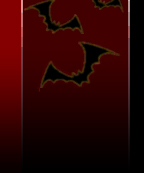|
Castlevania Weirdness

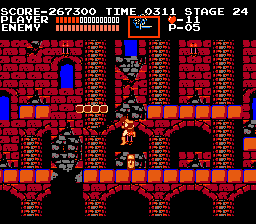

Here's an interesting Easter Egg from the original Castlevania thanks to Rob Strangman! Beat the game once and head to the second part of level two. Climb the stairs, get to the top of the screen and jump on the first moving platform. A blinking treasure will come out of the ground. If you examine it closely, it's a Moai head! Devoted Konami fans will recogize this Easter Island statue from the Gradius series, which seems to be obsessed with them for some odd reason. The same secret is also located in Castlevania Chronicles.
     
There are a number of unused items found in the ROM of the original Castlevania - most noteably a cross, a cupcake, and a love letter. Thanks to the Cutting Room Floor for this info.

Above is a picture of a backpack contributed by a reader Jean Greagor who won it off of eBay - and we have absolutely no clue what it is. It looks too high quality to be fan-made, although that color scheme certainly is pretty awful. Whatever it is, it's an amusing curiousity.
Since Castlevania was rather popular back in the day, Konami farmed it out to other companies to port it to other platforms. Naturally, the results were less than....good.
First off is the PC version. The game looked pretty similar, though the graphics looked a bit crappier, for some reason. Unfortunately, the biggest flaw is that it's incredibly jerky - animation, scrolling, everything lacks fluidity. What's more is if you don't have an old perfectly compatable Adlib soundboard, all of the music and sound effects will come through the PC Speaker. NOOOOOOOOOOOOOOOOOOOOOOOOO.
Next up is the Amiga version. This one actually looks pretty damn cool - almost all of the graphics have been redrawn entirely, and extra details added. The enemy design is somewhat questionable, however. The music, in Amiga MOD format, is pretty decent too. Unfortunately, the stumbling block here is the controls. There's considerable lag between when you hit the "attack" button and when your character actually whips. And since the "up" key is used for jumping, to use special weapons, you simply have to hold down the "attack" button for a second. Not very intuitive.
Some enemy patterns have been altered as well. There are a couple of amusing additions, such as the high score screen, and you can actually jump on stairs. And for some reason, the song that plays when Simon first enters the castle is the theme "Underground" from the Famicom Disk version of Castlevania - which wasn't used at all in the American/European cartridge release. As a side bit of trivia, this version was ported by Novotrade, who later made the Ecco the Dolphin games on the Genesis. They then changed their name to Appaloosa and butchered the two PSX Contra games.
A special thanks to MrPerfect of Mr. P's Castlevania Realm for the screenshots of the later levels - he had infinitely more patience than I, who quit in frustration around the second level. All of the screenshots can be found here.
Then there's the Commodore 64 version. I have to admit I have a fetish for the C64 SID (the music chip) so this version is cool just for the music. But the graphics are naturally awful (sub-NES quality) and the gameplay rather slow and iffy as well (damn them and their one action button - in many ways it suffers the same problem as the Amiga version).
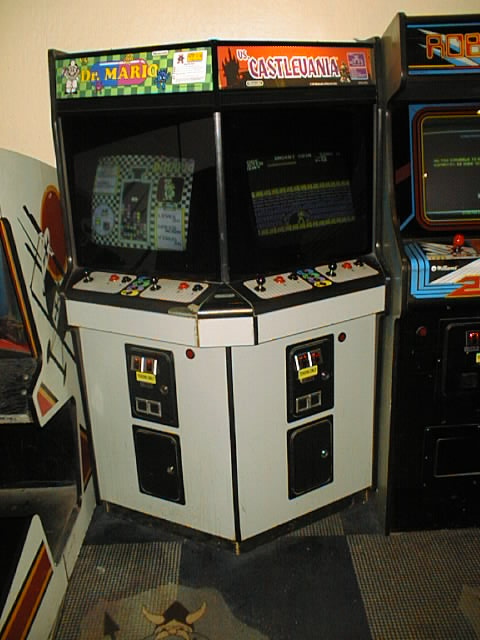
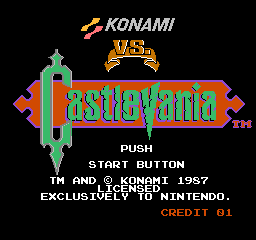 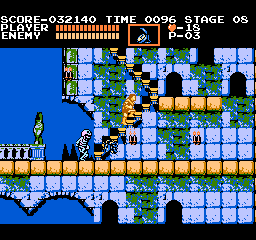
Nintendo had a system of arcade games known as the Vs. series. It basically amounted to two cabinets with two monitors linked together, running NES games, so people could play two player games on different screens. Games like Super Mario Bros. and Dr. Mario were released like this, as was Castlevania. The odd thing was that the two player mode was alternating, so there's wasn't much point to the two screens for this particular game. The only gameplay difference are the variable difficulty levels. There's the standard mode, which is the same as the regular NES Castlevania game except enemies do more damage. The Hard mode does even more damage - at some points, two hits will kill you. There are also minor palette differences, most likely due to the differences between a TV screen and an arcade monitor. Thanks to Morgoth Galaxius for this info.
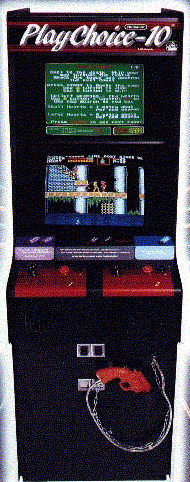
Castlevania was also one of the many games that made it on Nintendo's Playchoice 10 system (where you put in a quarter and got to play a selection of NES games for a limited amount of time.) It was the same as the NES game, just with the same slight color differences of the Vs. game.
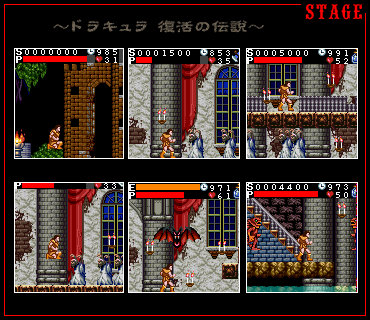
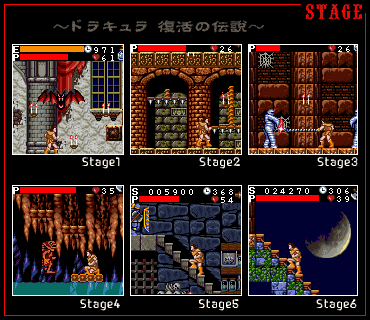
Castlevania also made it onto cell phones. There are three "parts" to it, with each part consisting of two levels each. While some of the backgrounds graphics have been touched-up, it doesn't look remarkably better than the original. And like most cell-phone games, is choppy and awkard to control.
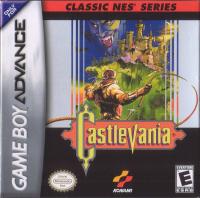
Castlevania also saw a release on the Gameboy Advance as part of the Famicom Mini/NES Classics line. Like all of the other games in the series, they are exact ports on the NES games, with an added save feature. The emulations are pretty spot on, even with the slightly stretched screen due to the difference in resolution. The Japanese version is a port of the Famicom Disk version, complete with name entry screen.
Back to Top
Castlevania Games - Castlevania - CV1 Weirdness
| 


